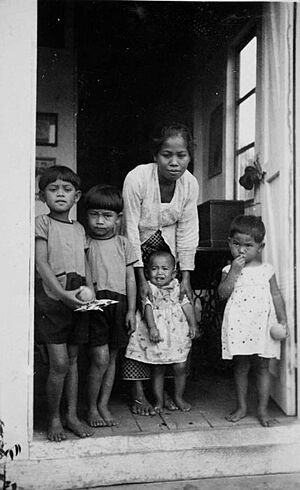Nanny facts for kids
A nanny provides child care for children within their family's home. In the past, nannies often worked in big, wealthy households. They usually reported directly to the lady of the house.
Today, modern nannies, like other domestic workers, might live with the family or come to the house each day. This depends on their situation and the family's needs.
Nannies are a bit different from other child care providers. A childminder usually cares for children in their own home. A mother's helper assists the family with general chores and also helps care for the children. An au pair is often a young person from another country. They live with a family to learn the language and culture, while helping with childcare. A governess teaches children inside their own home. A Kindergarten or schoolteacher does the same, but in a school environment.
History of Nannies
In the 1800s and early 1900s, nannies were often called "nurses." This job was almost always done by women. In a great house, like a large English country house, the nurse was a senior staff member. She managed her own area, called the nursery, with help from a nursemaid.
Because nannies were deeply involved in raising the children, families often remembered them fondly. They were sometimes treated more kindly than other junior servants. Nannies might stay with the same wealthy family for many years. They would care for several generations of children.
Nannies in Colonial Times
Nannies were also common in the homes of European officials in European colonial empires. It was typical for European children in these areas to be cared for by local women.
Colonial nannies often lived with their employers for many years. They might care for more than one generation of children. Sometimes, these nannies even traveled with the family when officials were moved to another country or colony.
- In British India, a nanny was known as an ayah. This word comes from "aia," meaning nurse or governess. Today, this term is used in many Indian languages for a female servant or maid.
- In China, a nanny was called an amah.
- In the Dutch East Indies, the household nanny was known as a baboe.
Different Types of Nannies
Live-in Nanny Roles
A "live-in" nanny lives in the employer's home. This arrangement is less common now but can be good for someone moving to a new area. A live-in nanny is responsible for all aspects of the children's care.
This includes washing their clothes and tidying their rooms. They also supervise homework and prepare meals for the children. Live-in nannies often take children to and from school and activities. Wealthier families often hire live-in nannies due to their flexibility. All living expenses for a live-in nanny are usually paid by the employer.
Some families use a "nanny share." In this setup, two or more families share the cost of one nanny. The nanny cares for the children from each family, often on a part-time basis. This can make professional childcare more affordable.
Night Nanny Services
A newer type of nanny is the night nanny. These specialists usually work with babies and young children. A night nanny might work with a family from one to seven nights per week.
They often help parents set up good sleeping routines for their child. They can also help solve existing sleep problems. Their roles and qualifications can vary by country. Night nannies work closely with the family's specific needs and parenting styles.
Maternity Nannies and Newborn Care
Historically, European women stayed in bed or at home for a long time after giving birth. Care was given by female relatives or a temporary attendant called a "monthly nurse." This period was called "confinement."
A modern version of this rest period helps new mothers, especially after a difficult birth. In the US, these special maternity nannies are called Newborn Care Specialists (NCS). They are highly trained experts who work with infants.
In Chinese and East Asian cultures, there is a tradition called zuo yue zi, or "sitting the month." Newborn care specialists for this tradition are called yue sao. They know about baby care and the customs for a mother's recovery after childbirth.
In Singapore and Malaysia, these specialists are known as confinement nannies. They help the mother care for the baby so she can rest well.
Who Becomes a Nanny?
Most nannies are women, typically ranging from their 20s to 60s. Younger workers are usually nursemaids or au pairs, not nannies in the traditional sense.
A few nanny positions are filled by men. The term manny is sometimes used for a male nanny, especially in the US and UK.
Related pages
See also
 In Spanish: Nana (ocupación) para niños
In Spanish: Nana (ocupación) para niños



